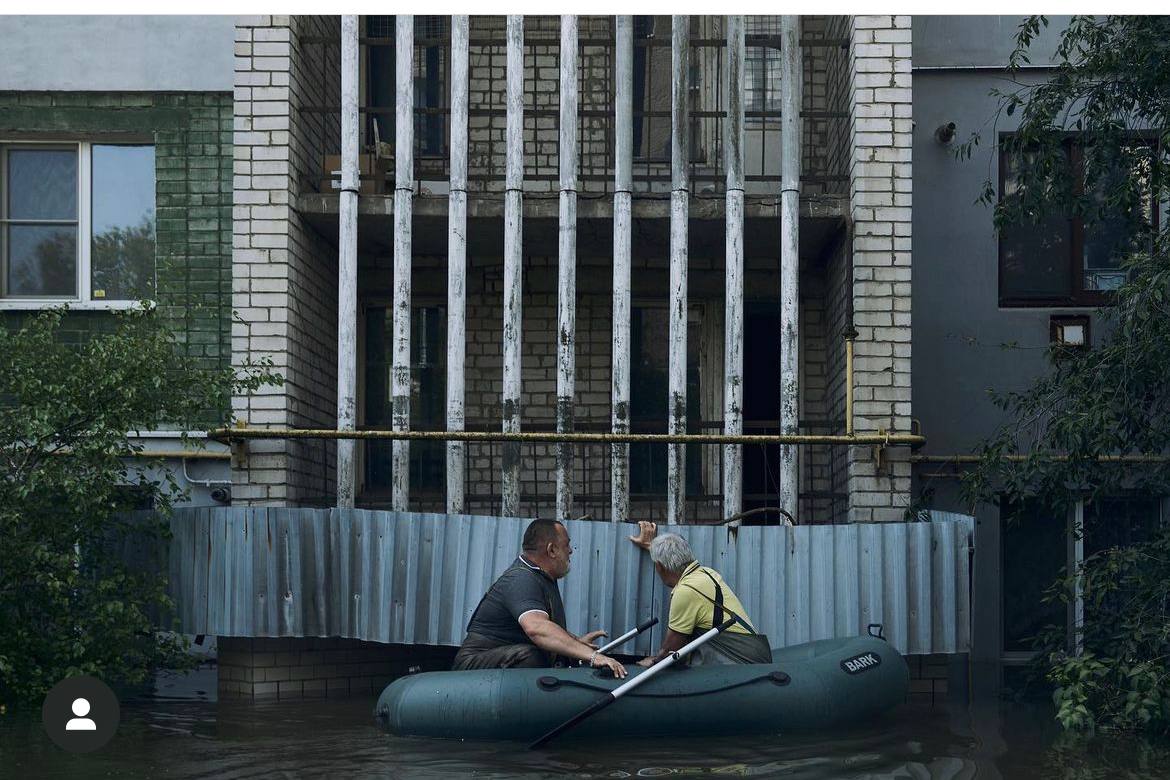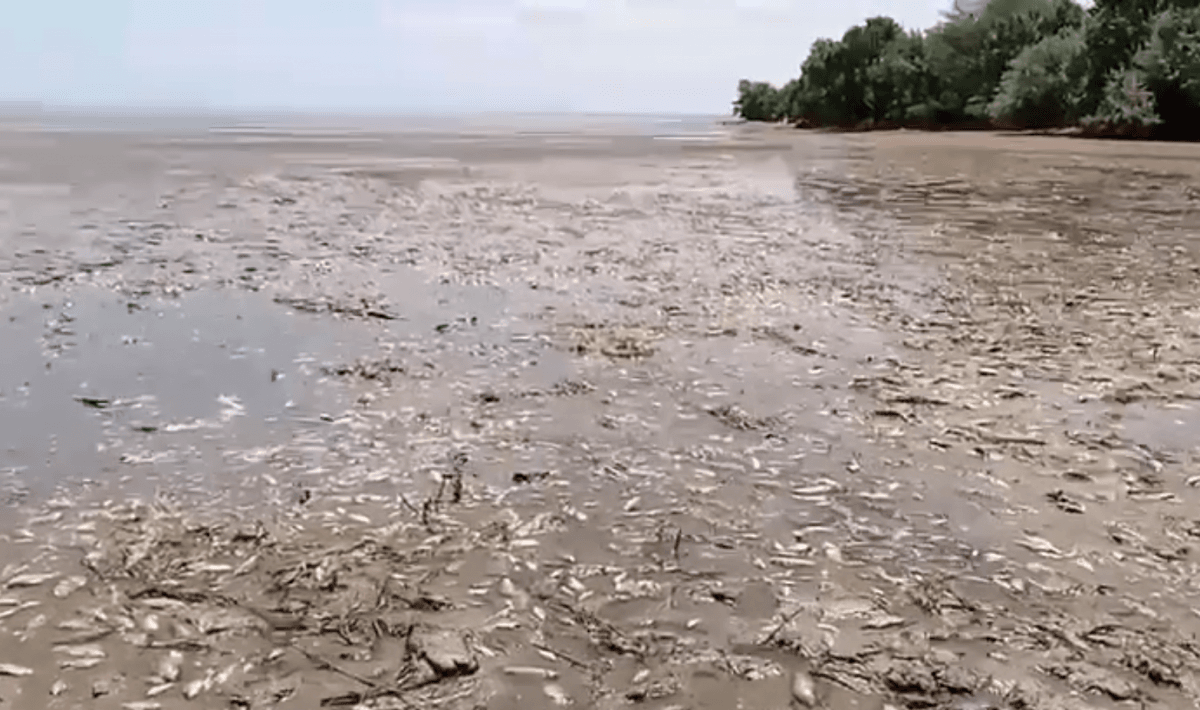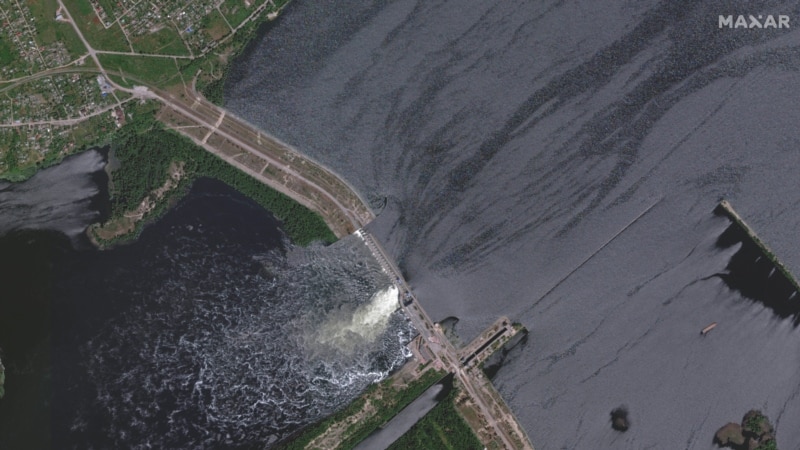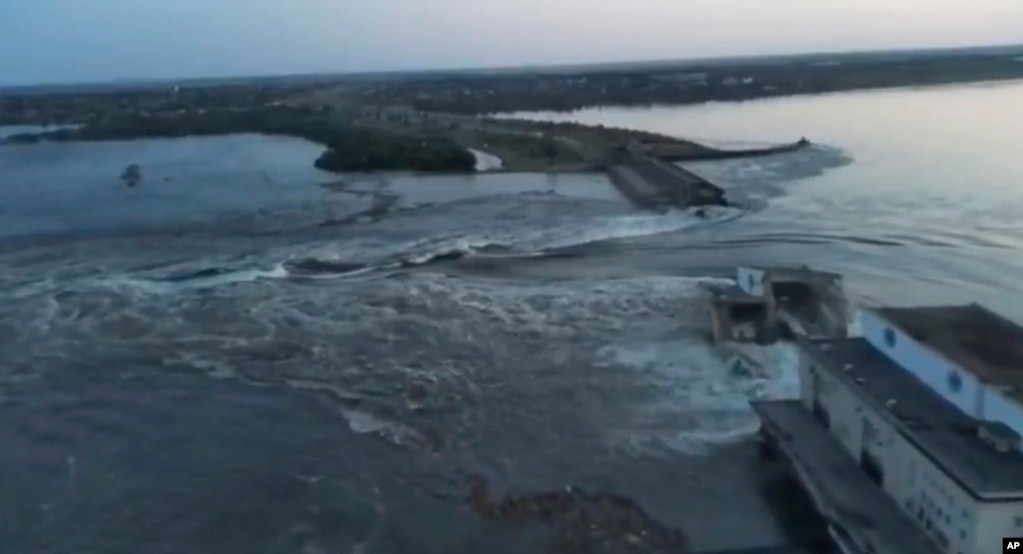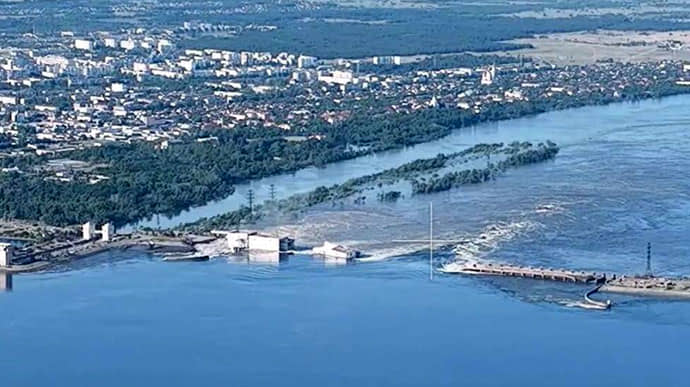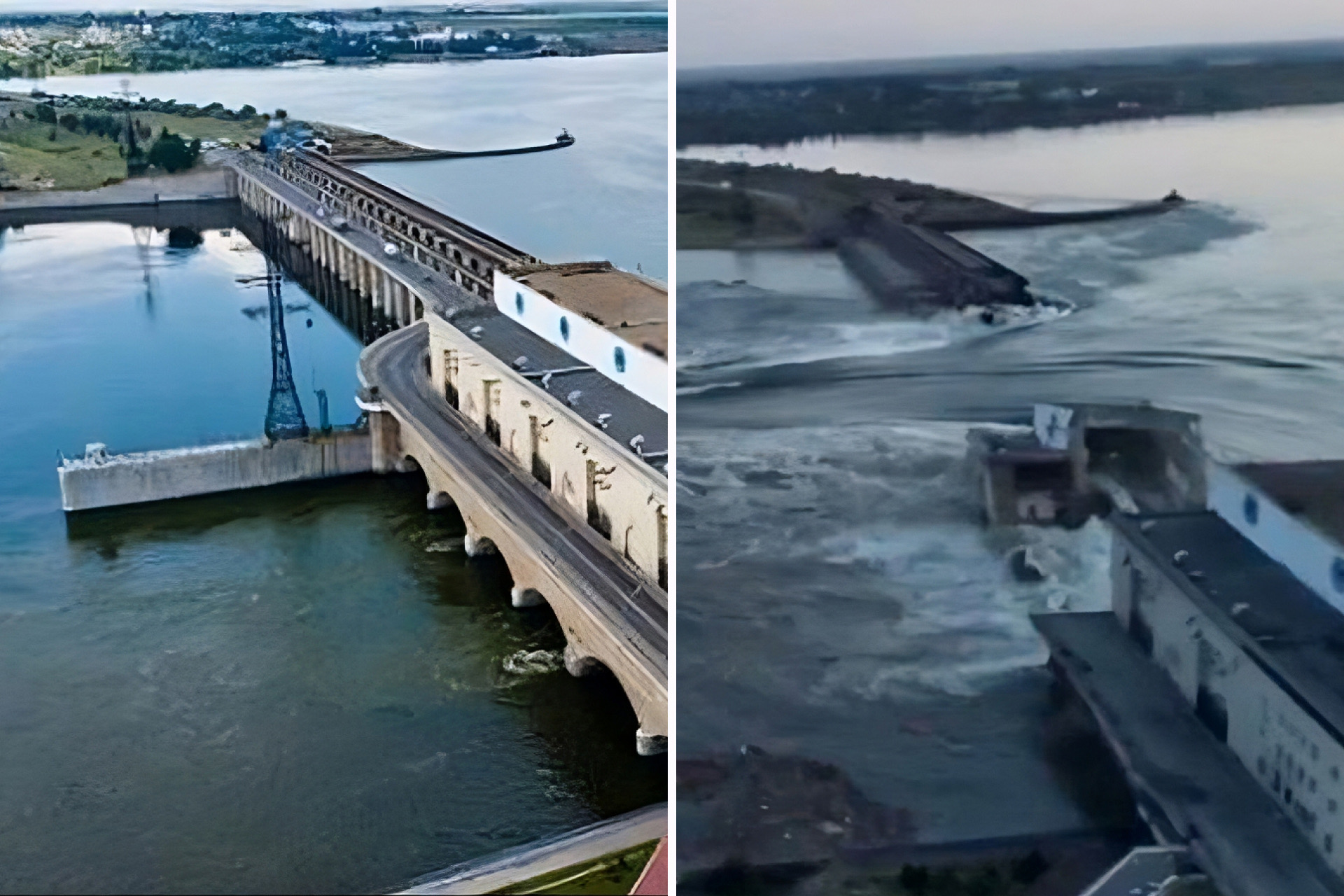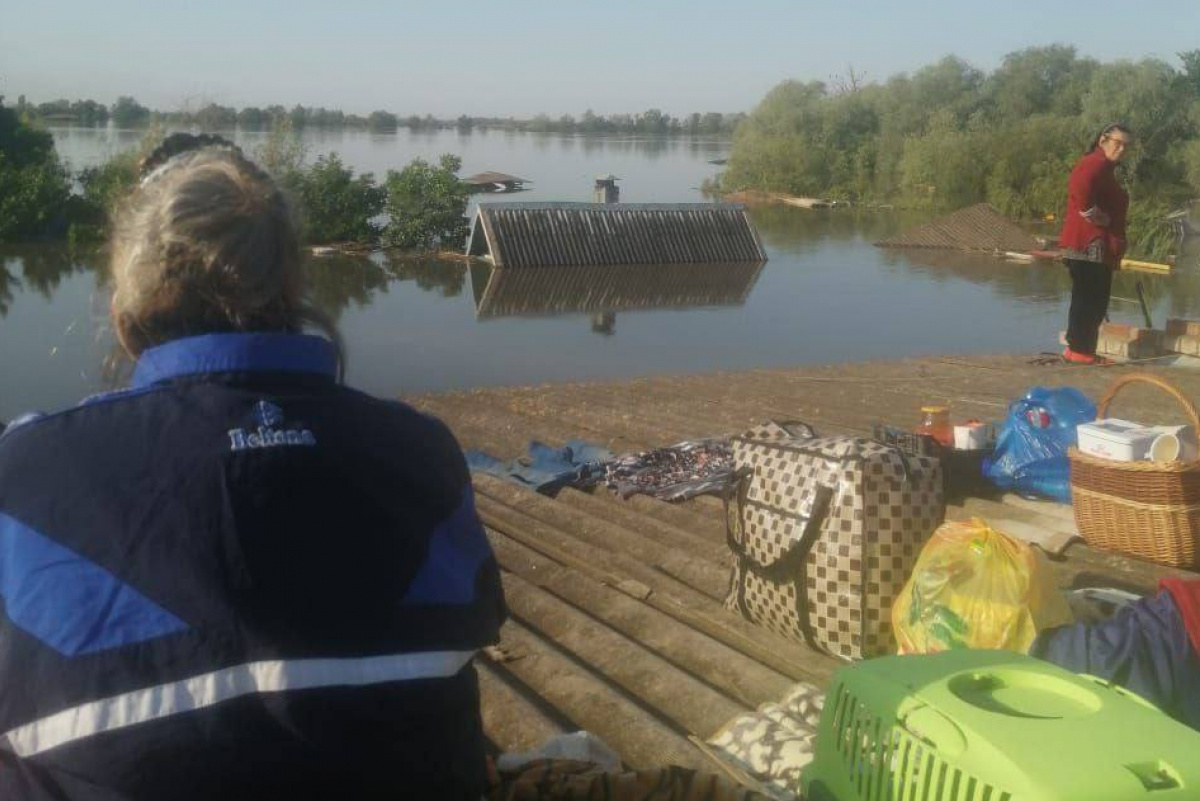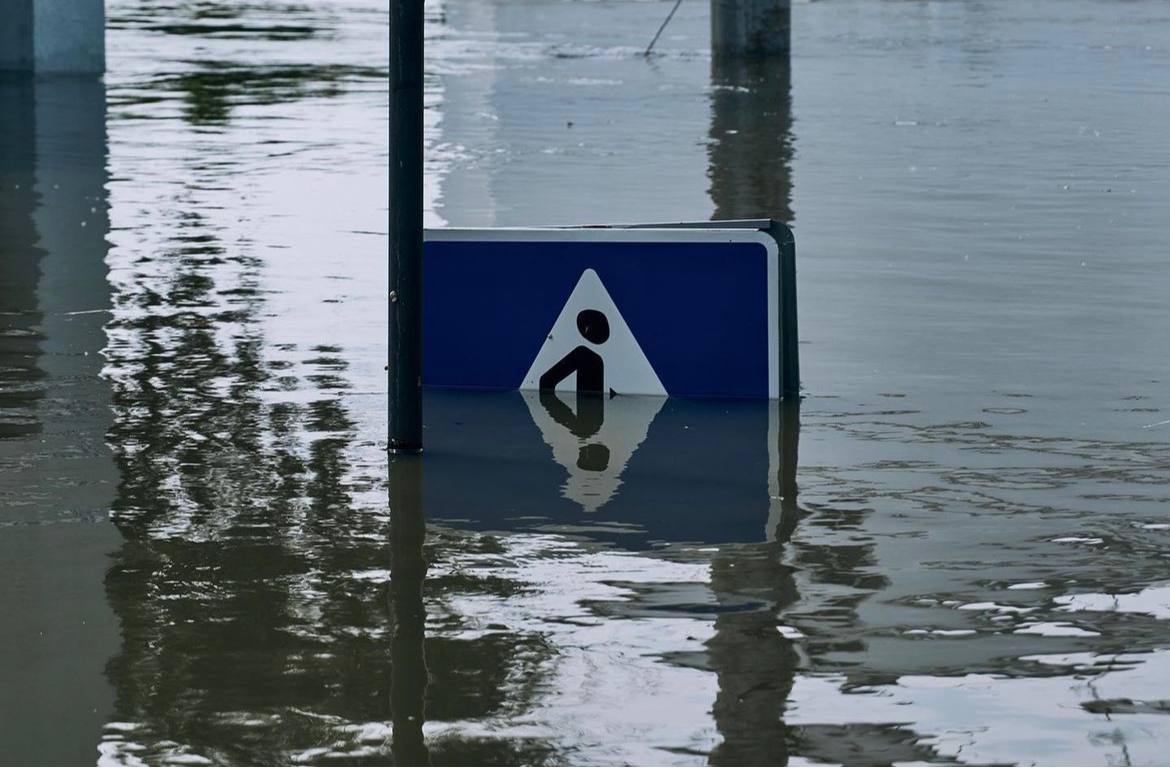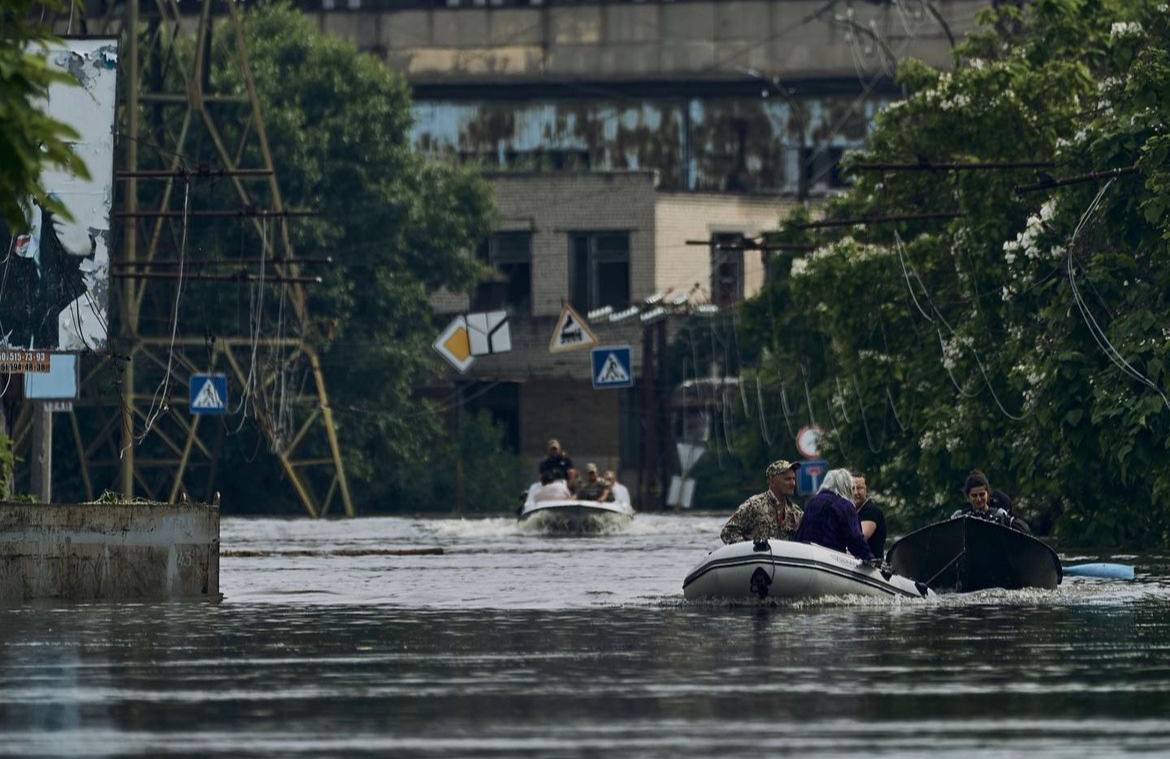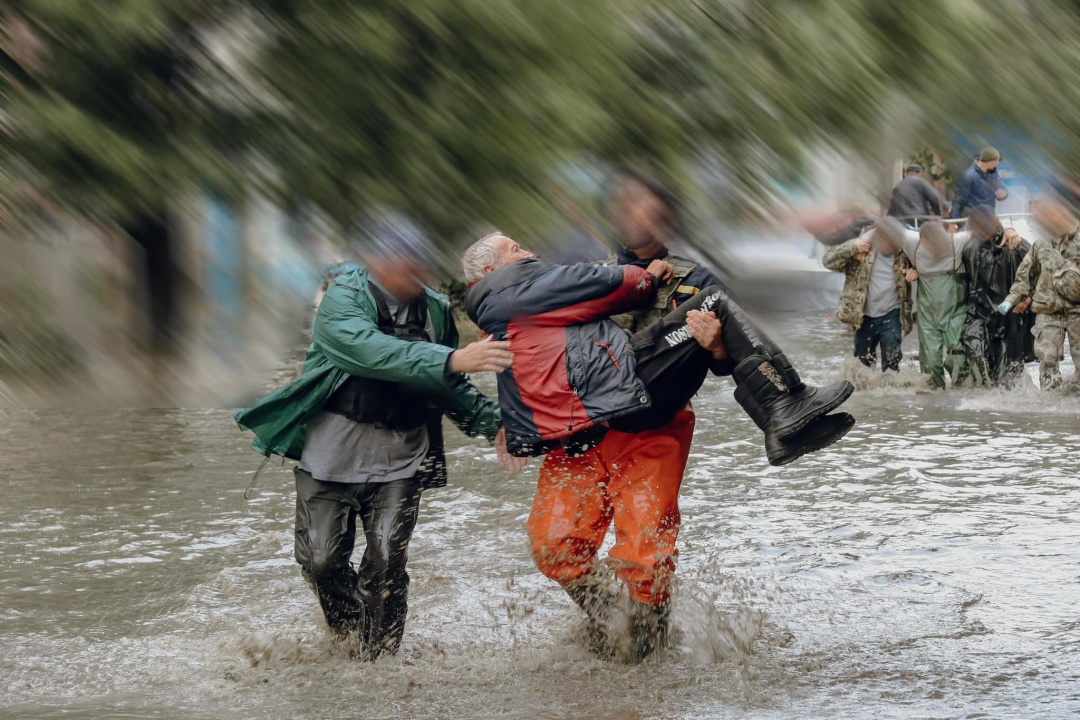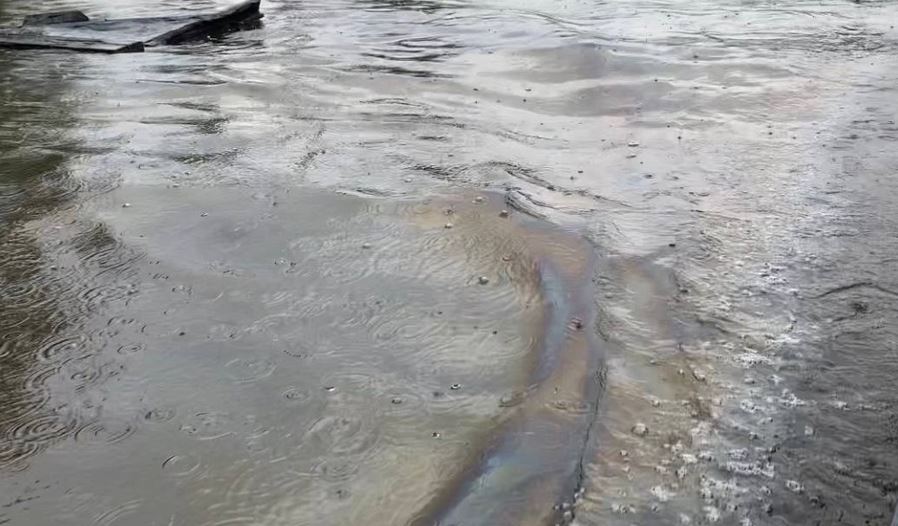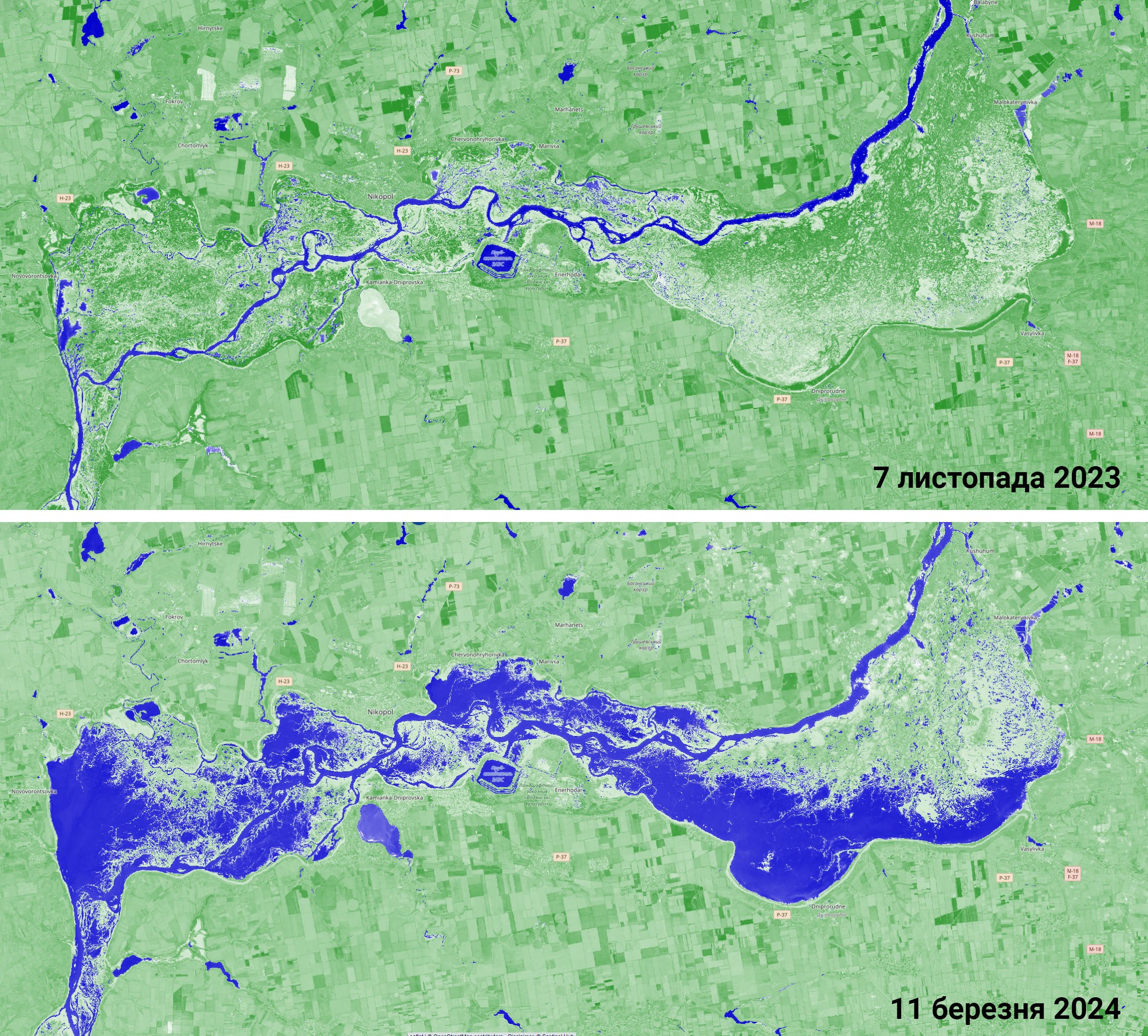Problems
The Kakhovka Hydroelectric Station was destroyed, tons of water poured out, and a flood occurred.
In the Kherson region of Ukraine, the Kakhovskaya hydroelectric power station was destroyed, tons of water poured out, a flood occurs. Kakhovka HPP is located 5 km from the city of Novaya Kakhovka, Kherson region. It has been operating since the 50s and requires regulation of the Dnipro flow for power supply, irrigation and consumption of arid southern requirements and navigation from Kherson to Zaporizhzhia. From the original North Crimean Canal, the reserves of the Dnipro water of the Crimean peninsula. The destruction of the Kakhovka hydroelectric power station means that Crimea lives without Dnipro water. On June 6, 2023, at 2.30 am, near the Russian invaders, the explosion of the dam of the Kakhovka reservoir. According to the Ukrainian operational command "South", the destruction of the Kakhovka hydroelectric power station, located on the Dnipro River, occurred. The water level downstream sharply accumulates, which threatens to flood many settlements. Ukrhydroenergo: Kakhovka HPP is destroyed and cannot be fixed. Many areas are de-energized in the following areas of safety. At the same time, the State Emergency Service of Ukraine predicts that there will be no flooding of the Kinburn Spit (it may flood roads). The Zaporizhzhia NPP is under threat (problems with reactor cooling). In Kryvyi Rih, the authorities are holding a sharp meeting on the choice of a city of water due to an emergency at the Kakhovka hydroelectric power station. The head of the Ukrainian Kherson city administration, Roman Mrochno, announced that evacuation had begun in settlements under the threat of flooding. The head of the Ukrainian Kherson Regional Administrative Administration, Alexander Prokudin, said that the water is gradually rising to a critical level, he is transporting residents to collect documents and essentials and wait for evacuation buses. The Ukrainian authorities say: "Russian troops staged another terrorist attack, now with possible negative consequences of a man-made nature." There will be high environmental, economic and humanitarian damage. There are reports of partial flooding in certain areas of Novaya Kakhovka, Oleshka, Dnepriana, Korsunka, Tyaginka, Lviv, Odradokamenka, Ivanovka, Nikolsky, Tokarevka, Ponyatovka, Belozerka and others downstream of the Kakhovskaya HPP. In particular, the zoo was flooded in Novaya Kakhovka. Tens of thousands of people were found in the flood observation zone.
Ecological consequences of the destruction of the Kakhovka HPP
The destruction of the Kakhovka HPP in the Kherson region will have serious environmental consequences: ● Water quality: The reservoir created by the dam acts as a buffer, allowing sediment and pollutants to settle before the water flows downstream. Without a dam, these sediments and pollutants will enter the river system, degrading water quality downstream. This can harm aquatic life, including fish and other organisms that need clean water. Sweeping away everything in its path, water is polluted with chemicals from industrial enterprises, mixed with sewage, etc. Epidemiological risks and risks of water pollution are multiplying. Water floods cars - it immediately "washes" them of oil and fuel, and smears wherever it flows. When water gets into basements, and warehouses with products, humidity rises, the process of decay and the spread of fungi begins. Pollution and poison from the flood zone quickly enter the groundwater, poison the rivers, and from there it enters the Black Sea basin. ● Loss of biodiversity: The reservoir and its surroundings are home to various plant and animal species. The destruction of the power plant will result in the loss of habitats and may lead to local extinction or population decline of species adapted to the reservoir environment. More than 50,000 hectares of forests have been flooded, and at least half of them will die. Tens of thousands of birds and at least 20,000 wild animals are at risk of death. It is obvious that the Kakhov reservoir has been turned into a big grave for millions of living creatures. ● Violation of migration patterns: many fish species use the Kakhovka reservoir during their migration cycles. The removal of the dam will disrupt these patterns, making it difficult for some fish species to complete their life cycles, such as spawning or access to preferred habitats. ● The destruction of the dam will change the natural flow regime, which may lead to erosion or silting downstream and affect the overall dynamics of the river ecosystem. ● Consequences of climate change. Hydropower is considered a renewable energy source with low carbon emissions. The destruction of the Kakhovskaya HPP will result in the loss of clean energy production capacity, which could increase dependence on fossil fuels and contribute to climate change. ● The North Crimean Canal begins from the Kakhovka HPP, providing the Crimean peninsula with Dnipro water. That is, the destruction of the Kakhovka HPP means that Crimea will be left without Dnipro water for 10-15 years. Enormous environmental, economic, and humanitarian damage will be inflicted. This humanitarian catastrophe will affect, if not a million, then hundreds of thousands of people. ● The problem of the irrigation system in the south of Ukraine will be added to the humanitarian catastrophe. We are talking not only about the shortage of next year's harvest but also about soil degradation over time, and changes in flora and fauna. This will affect both the Crimea and the entire south of the Kherson region. And this is the Krasnoznamensky Canal and rice systems in the Kalanchaksky district. This will have huge negative consequences for agriculture throughout the region. ● Undermining the dam poses a threat to the functioning of the Zaporizhzhya NPP. After all, the ZNPP is cooled by water from the Kakhovka reservoir. ● At least three national parks were partially flooded - Nizhnedniprovsky, Kamianska Sich, and Svyatoslav's White Coast. Thousands of animals may have died there.
32 objects with chemicals, oil and gasoline were flooded due to the explosion of the Kakhovskaya HPP
At least 32 gas stations, warehouses and oil refineries were flooded due to Russia's destruction of the Kakhovka hydroelectric plant. This can lead to the leakage of chemicals, oil and gasoline. This was reported by the Ukrainian representative office of the international non-governmental environmental organization Greenpeace on June 14. The organization conducted research based on satellite data. It showed that oil refineries, gas stations, thermal power plants and various warehouses were flooded — a total of 32 facilities. Also, according to preliminary information, at least 150 tons of engine oil leaked into the water in the first days of the disaster. "Even small amounts of chemicals are enough to contaminate soil and water bodies, and as a result, access to clean water will be difficult for many people," noted Greenpeace. It notes that particularly heavy pollution could cause industrial zones to flood, from where chemicals would be washed downstream, contaminating the Black Sea and coastal areas. And they emphasize that the consequences for aquatic organisms in the Kakhovsky Reservoir and the Dnipro River will be enormous. This will negatively affect the habitat of fish, birds, amphibians and animals in general, as well as pollute their habitat. "Where the water is receding, large-scale pollution by-products of the oil refining industry and industrial and household chemicals should be expected," Manfred Santen, a chemist at the German Greenpeace representative office, said. According to him, it is also necessary to investigate pollution by heavy metals. Soils and water bodies can be unsuitable for food production and as sources of drinking water for many years if they are not properly monitored and, if necessary, restored.
Gallery
15Timelines
2024
March
Water began to flow into the Kakhovka Reservoir again. As evidenced by the latest satellite images of the area, a significant part of the previously drained territory of the former reservoir is now covered with water. The explanation here can be very simple - the spring melting of snow brought additional moisture to the lower reaches of the Dnieper. “Here we observe a rise in the water level, which corresponds to the situation of spring floods on the river floodplain,” says an expert of the Ukrainian Environmental Group and, junior researcher at the Institute of Zoology. I. Schmalhausen NAS of Ukraine Grigory Kolomitsev. “In the absence of artificial regulation of water levels, today we can observe on the territory of the former Kakhovka reservoir the same processes that occur on natural river floodplains not regulated by humans. Spring floods occurred on these lands even before the construction of the hydroelectric power station for thousands of years,” added Kolomitsev.
2023
December 28
The water level in the lower water reaches 12.08 m, which is lower than the norm: ● minimum level, at which HPP hydroelectric units can operate at 2.42 m without limiting the tension; ● normal support level at 3.92 m. At the cooling unit of Zaporizhzhya AES, the water level is within the permissible norm. The monitoring of the content of drinking water does not comply with the standards. Dead bodies in the water area of the Kakhovsky reservoir and other plots of the river Dnieper have not been detected.
December 12
"Russia must be held accountable for environmental damage in Ukraine and pay compensation", - MEPs and the European Commission agreed in a debate entitled ‘Environmental consequences of the Russian aggression against Ukraine and the need for accountability’. "We all remember the destruction of the dam at Kakhovka Hydroelectric Power Plant on 6 June this year. This act caused widespread damage, submerging 620 square kilometers of territory, and impacting 100,000 residents directly. Ukraine estimated that the total recovery and reconstruction needs amount to €4.68 billion, of which roughly half is required immediately. Some of the damage will be irreparable for years. President Zelenskyy denounced the destruction of the Kakhovka Dam as ‘ecocide' and the ‘worst environmental disaster in Ukraine since Chernobyl' ", in - a speech by Executive Vice-President Dombrovskis at the European Parliament on the environmental consequences of the Russian aggression against Ukraine and the need for accountability.
September 09
Thanks to the coordinated work and conscious attitude of people, it was possible to avoid outbreaks of infectious diseases, including cholera. According to the calculations of the Ministry of Circulation, the estimated amount of damage caused to the Ukrainian environment due to Russia's detonation of the Kakhovskaya HPP is 146.4 billion hryvnias. To prevent the outbreak of infectious diseases and help people, 148 thousand tons of drinking and technical water were delivered to the emergency zone. In addition, the Centers for Disease Control and Prevention (CDC) issued 237,000 tablets needed to disinfect water. With the help of tablets, it was possible to disinfect drinking water for the population's water supply enterprises and critical infrastructure facilities. As the chief state sanitary doctor said, "To prevent the deterioration of the sanitary situation, three infectious disease centers were deployed in the affected areas to treat patients with suspected acute intestinal infections and cholera." All infectious disease centers were provided with special sets of medicines. At the same time, more than three thousand people with acute intestinal infection were examined for cholera. In no case was cholera detected. The Ministry of Health also noted that in the territories of the Mykolaiv and Kherson regions that were flooded, experts examined more than 100 soil samples. It was possible to do this when the water completely receded from the territories of the affected communities, and the land dried up. In the future, monitoring of sea and river water, as well as water from surface reservoirs will continue. "Part of the ecosystems have been lost forever. They will not recover. We are left with endemic species of animals. These are species that existed only in one place on earth - in the South of Ukraine. We have lost half of the forest in this territory," the Minister emphasized. The minister explained that the Russians committed a crime during the season of mass breeding and killed many animals that did not even have time to be born.
September 06
As a result of the Russian detonation of the Kakhovsky Reservoir, the desertification (aridization) trends of southern Ukraine may intensify. This area will become a desert. Vladyslav Dudar, an officer of the Main Department of Mine Action, Civil Protection and Environmental Safety of the Ministry of Defense of Ukraine, stated this. As the representative of the Ministry of Defense stated, because the ecosystem of the Kherson region is mainly anthropogenic, and due to the lack of agriculture, the draining of the Kakhovsky Reservoir can negatively affect the process of desertification in the south of Ukraine.
September 01
Ukraine coped with the main stage of liquidation of the disaster at the Kakhovskaya HPP. This was reported by the Minister of Internal Affairs Ihor Klymenko. What were the consequences of the Russian terrorist attack on the Kakhovskaya HPP: ● 180 settlements in the Kherson, Dnipropetrovsk, and Mykolaiv regions were in the emergency zone. About 900,000 people lived there. ● About 700,000 Ukrainians were left without access to drinking water. They received aid in the form of 148,000 tons of drinking and technical water, and almost 119,000 tons of food and essential supplies.
August 30
The main stage of liquidation of the Russian terrorist attack at the Kakhovskaya HPP has been completed. This was reported by the Ministry of Health. Since the Headquarters for the elimination of the consequences of an emergency has already completed its work, in the future the situation will be controlled by emergency services, each of which will be responsible for its direction. This is reported by Antireid concerning "Human Rights in Ukraine".
July 19
Russian responsibility for intentionally destroying the dam has been established through a thorough analysis of the structural engineering plans of the Kakhovka dam, and scrutinizing seismic and satellite data related to the explosions. Only the Russian military, which controls the Kakhovka dam and had full access to the inner subterranean gallery of the power plant, could have engineered such an explosive rupture of the dam. Monitoring and measuring environmental damages in a war zone is extremely difficult and dangerous, and manpower and equipment are scarce. But a good deal of monitoring can be conducted indirectly, by the extensive satellite monitoring systems of both the U.S. and Europe, many of which focus on changes in environmental variables. E.g. NASA’s Earth Observing System (EOS), has a family of satellites that focus on measuring land use, soil moisture, vegetative cover, agricultural crop production, forest growth and associated diseases and water quality. Most importantly, these satellite systems can provide comparisons of the state of the environment ‘before, during and after’ the war – in other words, the very important time series profile of changes in key environmental variables that can be used to assess damages. They can be used to confirm whatever ‘ground truth’ monitoring may be available, which would be used to calibrate the satellite data and, using artificial intelligence, fill in gaps where there is no data available. Satellites and GIS technologies are already being used to assess infrastructure damage and the consequences of forest fires and flash floods in Ukraine. These satellite systems, together with well-developed Ukrainian GIS technologies, will be invaluable assets for the ultimate assessment of ecological damage and reparations. According to the Ukrainian Ministry of Agriculture, the destruction of the dam will leave 584,000 hectares (1,440,000 acres) of land without irrigation, turning them into “deserts”.
July 01
According to the press service of the Ministry of Economy of Ukraine, according to the analysis of the KSE Institute, damages due to the destruction of the Kakhovskaya HPP include the following: ● $1.5 billion in damage was caused to the environment and ecology – 150 tons of oil leaked during the dam explosion. ● the salinity level of the Black Sea near Odesa is now almost three times lower than normal. The problem of silt pollution also exists for the territories above the Kakhovskaya HPP. After the water has gone, this bottom sediment dries out and can be blown away by the wind: "This layer is quite thick. Everything is the same - heavy metals, radionuclides, DTT, pesticides and so on. When all this dries up, it may happen that under the influence of our dry weather, because there are already small hints of the return of dust storms. And this is a threat to people's lives and health", - shares Zaporizhia scientist, doctor of biological sciences, head of the Department of General and applied ecology and Zoology of the Zaporizhia National University Oleksandr Rylskyi.
June 27
According to the results of the research, cholera vibrio was not isolated in the water, but cholera-like vibrio (which is a marker for the possible presence of cholera vibrio) was isolated in the following places: – Ingulets town – Snigurivka town; - Buzky estuary - "Chaika" beach, "Namiv" recreation area in the city of Mykolaiv; - Ingul river - Mykolaiv city – Dnipro-Buzky estuary According to microbiological indicators, lactose-positive Escherichia coli (with a permissible level of 5000 units) is: - Ingulets - 240000000 – Dnipro-Buzky estuary – 6,200 – 13,000; The sanitary and chemical parameters of the Ingulets River did not meet the standards of dissolved oxygen, dry residue, chlorides, iron, and biological oxygen consumption, and in the Dnipro-Buzka estuary, the maximum permissible concentrations of ammonia were exceeded. There are no oil products or pesticides in the samples taken for research.
June 15
The public organization All-Ukrainian Environmental League together with scientists and public activists discussed the environmental problems that arose during the ecocide - the blowing up of the Kakhovskaya HPP dam. One of the key issues of the meeting is whether the Kakhovskaya HPP should be restored. A large number of scientists are against the restoration of the Kakhovskaya HPP in the future. After all, the construction of the Kakhovskaya HPP, in general, the regulation of the Dnipro led to many negative consequences for the biota. So is it worth repeating?
June 13
Flooding after the explosion of the Kakhovskaya HPP led to water pollution with fuel and lubricants and toxic chemicals. Specialists have already discovered cholera and Escherichia coli in the Kherson region, and rotavirus, salmonella and astrovirus on the beaches of the Odesa region. Oleg Pavlenko, head of the Department of State Environmental Supervision of Land Resources of the State Environmental Inspection of Ukraine, announced this during a briefing at the Military Information Center. "Every day we take water samples and do analyses. There is no very high pollution, but there are already several cases of detection of cholera and kish bacilli. In parallel with us, an analysis of the SES, which is checking the sanitary and epidemiological situation, is being done, because a lot of settlements, courtyard buildings, and sewers were flooded." We study water in terms of chemistry, and they are specialists of the sanitation station in biology," he said. Fortunately, no disease outbreaks have been recorded. Oleg Pavlenko urges residents of the southern regions not to drink water from wells, as it can be dangerous for health. To begin with, it must be checked in the laboratory for the presence of dangerous substances or bacteria.
June 13
As a result of the explosion of the Kakhovskaya HPP in the Mykolaiv region, almost 654 hectares of plantations of the Sniguriv forestry branch of the "Bashtan Forestry" branch were flooded. The water level is falling, and 400 hectares remain flooded. The water continues to recede. And this allows us to proceed to the next stage of elimination of consequences. Water pumping has begun in some settlements. In the Kherson region, it has already been confirmed that about 1,300 hectares of agricultural land have been flooded as a result of the Russians blowing up the Kakhovskaya HPP. Specialists did not find oil products in the water in the Kherson region in communities affected by flooding. This is reported by Kherson OVA. The analysis of water in Ingulka (near Velika Oleksandrivka) showed an excess of the maximum permissible concentration: suspended solids (18%), sulfates (60%), chlorides (243%), dry residue (283%). The content of dissolved oxygen is 3.5 mg/dm3 with a norm of at least 4.00 mg/dm3. In the Dnipro, samples were taken near the railway bridge outside Kherson. The results showed an excess of suspended substances, which is 76%, and total iron - 280%. The content of dissolved oxygen is 3.8 mg/dm3 with a norm of at least 4.00 mg/dm3. There are no significant deviations and excesses of norms for other pollutants in the Dnipro.
June 12
Six mines have already been discovered on the sea coast of the Odesa region after the Russian invaders blew up the Kakhovka hydroelectric power station within a week. Amphibians and freshwater fish, which entered Odesa Bay from the Dnipro after the hydroelectric power plant was blown up, may die shortly. This was announced by the head of the "Green Letter" organization, ecologist Vladyslav Balinsky. "The quality of water in the reservoirs of the Mykolaiv Oblast as a result of the explosion of the Kakhovsky Reservoir has an excess of coliforms, so swimming, catching and selling fish are currently strictly prohibited," Vitaliy Kim emphasized. In the Sniguriv district of the Mykolaiv region, 400 hectares of forest plantations remain flooded, which complicates the demining of the territory, reports the press service of the State Enterprise "Forests of Ukraine". "The reservoir has decreased by 50%. As for the volume, according to our estimates, there is 60-70% less water in the Kakhovsky reservoir than it was before the explosion," said the general director of Ukrhydroenergo. Border guards recorded uncontrolled explosions of ammunition, which, together with fragments of household items and garbage, were carried into the Black Sea by water from the Kakhovsky Reservoir. DPSU urges citizens not to remove anything from the water on their own.
June 11
The water level in the Dnieper at the Kherson mark has dropped by 3 meters and is 2.6 meters. The water level drops by 1-5 cm every hour. According to the calculations of the Ukrainian Hydrometeorological Institute based on satellite images, 309 square meters were flooded in the Kherson region. km During the inspection, an oil stain was discovered in the flooded area of Kherson, the Kherson City Military Administration reports. As a result of Russian troops undermining the Kakhovskaya HPP dam, the Black Sea began to desalinize, the salinity of the water near Odesa is almost three times lower than normal, reports the State Environmental Inspection of the South-Western District.
June 10
The amount of garbage in the waters of the Black Sea near the shores of the Odesa region is only increasing. Remains of houses can be seen, and animal corpses, fragments of household furniture, and other garbage are nailed to the coast. Exceeding the permissible level of harmful substances was recorded in the Ingulets River in the Kherson Region. Thus, according to the results of laboratory studies, there is an excess of the concentration of ammonium nitrogen, total iron, and suspended solids. The content of dry residue also increased, which is explained by the natural background of the river.
June 08
During a working trip to the Dnipropetrovsk region, the President of Ukraine Volodymyr Zelenskyy held a meeting in the format of a video conference with representatives of the global community of political and public figures, opinion leaders and experts in the field of environmental protection. In his speech, the President of Ukraine emphasized that the disaster at the Kakhovskaya HPP is not a natural disaster and not a manifestation of the climate crisis, it is a disaster ordered by Putin personally. "This Russian crime of ecocide is the biggest in Europe for decades, but, judging by everything, the Russian occupiers have decided to further worsen its consequences. In the occupied part of the territory, where about a dozen settlements have been flooded, there is no evacuation at all. For the second day, people are on the roofs, in a water trap, without drinking water, food and medical assistance. We do not yet know how many dead and injured there are," Volodymyr Zelenskyi noted. The head of state also drew attention to the fact that due to the destruction of the Kakhovskaya HPP dam, fuel storage facilities, warehouses with chemicals, fertilizers, and animal burial grounds, including two "Siberian burials" in the temporarily occupied territory, were flooded; sewage got into the water. He called on the world community to help attract the attention of international organizations to help the people who remained in the temporarily occupied territory affected by the flooding. "And so please spread the truth about this Russian ecocide. Please call on leaders, states, and international organizations to act," added the President of Ukraine.
June 08
The flood caused by the destruction of the Kakhovka dam has reached the Mykolaiv region, and at least 13 settlements are under threat, Governor Vitaly Kim reported on June 7. The population of Snigurivka and 13 settlements along the Ingulets River are in the greatest danger, as water from the spilled Dnipro River enters Ingulets. "As a result, the water level (Ingults) is rising even more than in the Dnieper itself," the governor explained. The water level in Mykolaiv has risen by 82 cm, the mayor Oleksandr Senkevich said. Beaches, moorings, transport stops, a yacht club and restaurants on the banks of the Dnipro-Buzka estuary in the city were flooded. The State Emergency Service reported that 166 people were evacuated from the region.
June 07
BBC News reports: "On Wednesday morning, 23 localities remained flooded, Ukrainian TV said in its latest news bulletin. Meanwhile, Kherson's Russian-installed authorities declared a state of emergency in the parts of the region they control. Some reports suggest that water levels may be dropping in the town of Nova Kakhovka, closest to the dam, as the vast reservoir behind it quickly empties. But flood waters may not peak in Kherson for another 20 hours, Interfax Ukraine news agency quoted Kherson Governor Oleksandr Prokudin as saying. Mr. Prokudin added that Russian forces had shelled parts of the region including the city of Kherson several times and that one person was killed and one injured. Nova Kakhovka's Russian-appointed mayor Vladimir Leontyev said the village of Korsunka was now completely underwater, with flooding up to roof level in three other villages. Some residents were seen desperately trying to save their belongings in homes with water levels nearing the ceiling. The Kakhovka dam, downstream from the huge Kakhovka reservoir, provides much-needed water to farmers and residents, as well as to the Zaporizhzhia nuclear power plant. It is also a vital channel carrying water south to Russian-occupied Crimea. The peak of a huge water spill downstream from the emptying reservoir was expected on Wednesday morning, warned Ukraine's state-owned hydropower plants administrator Ukrhydroenergo. It said this would be followed by a period of "stabilization", with the water expected to rapidly recede in four to five days. There are concerns about the Zaporizhzhia nuclear power plant - Europe's largest - which uses reservoir water for cooling. The situation there is said to be under control and there is "no immediate nuclear safety risk" for the plant, according to the International Atomic Energy Agency (IAEA). There are also concerns about desertification, with agricultural land washed away by flood waters and the negative consequences of the flooding likely to be felt for years. Ukraine's agriculture ministry said 10,000 hectares of agricultural land on the Ukrainian-controlled bank of the Dnipro had been flooded, and several times more on the occupied bank." UNIAN reports: "After the terrorist attack carried out by the Russian occupiers at the Kakhovka HPP, a plague of fish has been observed in the Kherson, Mykolaiv, Zaporizhzhya and Dnipropetrovsk regions. Residents are urged not to eat it under any circumstances. The Ministry of Health has warned that in the coming days, a fish plague will be observed in the Kherson and Zaporizhzhia regions due to a rapid drop in the water level. The second day of the fish plague is also observed in the Mykolaiv region. Against this background, catching and selling fish has been completely banned in the territories of the Snigurivska and Horohivska communities for the next 10 days. Dozens of settlements were flooded, and the Kakhovka HPP was completely submerged and cannot be restored. As a result of the explosion of the Kakhovka HPP, 150 tons of engine oil got into the Dnipro River, and there is a risk of leakage of more than 300 tons. Threats have been created for the water supply systems of the Zaporizhia and Dnipropetrovsk regions of the occupied Crimea. There are risks for the Zaporizhzhya NPP, which uses water from the Kakhovsky Reservoir for cooling. As a result of the drop in the water level, fish - both young and adults - are already dying en masse. The flow of water will carry freshwater fish and other biological resources to the salty waters of the Black Sea, which poses a threat to the Black Sea fauna as well. According to preliminary estimates of the Ministry of Agriculture, losses to the fishing industry from the death of only adults can reach 95 thousand tons or about 4 billion hryvnias. Total losses from the death of all biological resources will amount to 10.5 billion hryvnias."
June 06
According to the Ukrainian operational command "South", the destruction of the Kakhovka hydroelectric power station, located on the Dnipro River, occurred. The water level downstream rises sharply, which threatens to flood many settlements. Ukrhydroenergo: Kakhovka HPP is destroyed and cannot be punished. Many areas are de-energized in the following areas of safety. At the same time, the State Emergency Service of Ukraine predicts that there will be no flooding of the Kinburn Spit (it may flood roads). The Zaporizhzhia NPP is under threat (problems with reactor cooling).
2022
November
During the Russian retreat from the right bank of the Dnipro, the Russians blew up seven bridges across the Dnipro, including the bridge at the Kakhovka hydroelectric power station. The dam of the Kakhovka hydroelectric power station itself was also damaged.
October
It was reported that water was released from the Kakhovka HPP amid constant shelling to reduce the area of flooding in case of damage to the dam.
April
According to Ukrainian intelligence, the invaders carried out the main work of mining the dam. The locks and pillars of the Kakhovka hydroelectric power station were mined. According to experts, the destruction of the Kakhovka hydroelectric power station would threaten the Zaporizhzhia nuclear power plant, which uses water to cool nuclear reactors from the Kakhovka reservoir.
February
The station was captured by units of the Russian Armed Forces that attacked the Kherson region from the Crimean peninsula annexed by Russia in 2014.
